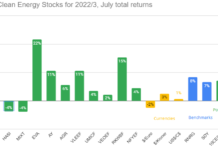Tom Konrad, CFA
I recently published a quick guide to a green or fossil fuel free stock portfolio aimed at the small investor. For most people, the best options will be to use mutual funds or an investment advisor. Some of us like to do things ourselves, and build a portfolio from scratch, using individual stocks. Doing so could rapidly become a full-time job, but it does not have to be. Instead, you can use information which mutual funds disclose to piggy-back on their research. Garvin Jabusch, Co-Founder and CIO of Green Alpha Advisors in Boulder, Colorado, recently told me, “If I were a doctor or a lawyer, I’d probably use this strategy.”
The Stock Lists
Technology Ticker
Beta
Yield
INTC 1.60 3.5% CSCO 1.26 2.9% IBM 0.67 2.1% QCOM 0.85 1.8% AMAT 1.82 2.0% ORCL 1.14* 1.1% GOOGL 0.94 – FSLR 5.9 – CSIQ 2.84 – SCTY 5.7* – Healthcare Ticker
Beta
Yield
MRK 0.50* 3.1% RHHBY 0.77 2.9% NVO 1.08 1.4% GILD 0.98 – NVZMY 0.50 0.6% Industrial VE 1.75 5.3% PNR 1.24 1.3% PWR 0.62 – GNRC 0.89 – Consumer Defensive Ticker
Beta
Yield
PG 0.41 3.1% PEP 0.31 2.6% UNFI 0.65 – Consumer Cyclical JCI 1.77 1.8% TSLA 1.37 – Financial TD 0.56 3.4% MET 2.20 2.4% Real Estate JLL 2.02 0.4% Utilities ITC -0.10 1.5% Data from Morningstar.com except * from Yahoo! Finance
I’ve used the top 10 holdings of these three funds to compile the list of stocks shown in the box at right. The sector designations (Technology, Healthcare, etc.) are the categorizations given by Morningstar. I also used Morningstar (with a supplement from Yahoo! finance to determine each company’s dividend yield and Beta, which is a widely used measure of a stock’s market risk.
Garvin Jabusch, co-manager of the Shelton Green Alpha mutual fund.
One criticism of green mutual funds is that they tend to be heavy on technology and healthcare stocks, and you can see this is clearly the case with the list I’ve compiled to the right. The next step is to correct for this bias.
Balancing The Portfolio
A “Balanced Portfolio” usually refers to a portfolio containing a “balance” of different security types, usually equities (stocks) and fixed income (bonds.) According to conventional financial theory, the right “balance” for you depends on your financial resources and risk tolerance. There are any number of online calculators and questionnaires available which will take this sort of personal data and produce a portfolio allocation.
This article is mostly about the stock or equity portion of the portfolio. For the fixed income portion of the portfolio, the best choice is to reduce your debt. Your own debt is probably someone else’s fixed income security. By paying down that debt, you are essentially buying it back from that investor, and also saving yourself the overhead costs that are built into the loan. If you have no debt, you will be able to bear more risk and invest more in equities.
Other green income options include increasing the energy efficiency of your home, installing solar (and paying for it up front as opposed to using a lease, which is financially similar to purchasing the solar system with debt), the crowd funding site Solar Mosaic (when they have projects available), or a bank CD with a relatively green bank such as Capital Pacific Bancorp (CPBO) or Toronto-Dominion Bank (TD), which also happens to be included in the stock list to the right.
I personally feel that current interest rates are too low to make traditional fixed income investing attractive, and instead use a portfolio of high-income equities. While the financial theory that gives us the portfolio allocation referenced above assumes that there is a natural trade-off between return and risk, real world research only finds that trade-off between asset classes (i.e. stocks have higher risk and return than bonds) but not within asset classes (risky stocks do not have higher returns than safer stocks.) This is called the low-risk anomaly (a.k.a. low-beta anomaly or low-volatility anomaly.) Historically, low-risk stocks have actually produced higher returns than high-risk stocks.
A consequence of the low-risk anomaly is that a portfolio of low-risk, high yield stocks is likely to have higher returns and yield than typical portfolios of stocks or bonds, or combinations of the two. This is why my annual portfolio of ten clean energy stocks contains six high-yield stocks this year. That list could also be substituted for the holdings of a mutual fund when generating the list of stocks to build your portfolio.
Diversification
The benefit of owning a large number of stocks is diversification: so your investment can’t be lost due to bad news for a single company or sector. For the small stock investor, diversification comes with a trade-of of higher transaction costs. To keep these costs low, I try to keep brokerage commissions to no less than 0.5% or 1/200th of any transaction, and trade as little as possible. That means that if you pay $8 per transaction, each position should be at least $1,600 (=$8 x 200.) For a $20,000 account, that means you can have as many as 12 positions. If your portfolio is too small to have 10 positions using this rule, you’re probably better off opting to the diversification of a mutual fund until you can increase it. As the account grows, let your transaction size grow, to further reduce investment costs. 20 positions should be plenty for the purpose of diversification if you are careful to select stocks in a wide range of industries so that they behave differently in various economic conditions.
To select a 10 stock portfolio from the list I have compiled to the right, I first select the stock with the best combination of low beta (to take advantage of the low beta anomaly) and high yield (to compensate for not including fixed income.) That gives me eight stocks: INTC, MRK, VE, PG, JCI, TD, JLL, and ITC. I then choose the next two highest yielding low beta stocks, making sure I don’t have more than two in any industry: RHHBY and PEP.
If you buy equal dollar amounts of each, you have a moderately diversified, low cost, low beta, relatively high yield (2.8%), fossil-free portfolio.
Closing The Circle
I discussed this strategy with Jan Schalkwijk, a green investment advisor at JPS Global Investments. He pointed out that it is very important not just to buy the stocks and forget about them, but also “close the circle.” To follow this strategy effectively, you need to put in place a plan to update the portfolio periodically. In 2009, I put together a 5-stock “tracking portfolio” that was designed to mimic the performance of the alternative energy mutual funds using a similar procedure. I checked back on the portfolio six months later, and it was out performing the funds, but then I forgot about it until I started thinking about this article. I checked the performance, and the portfolio was up only 1.5% over five years, equal to the worst performing of the three mutual funds, and far behind the average return of 61%. The biggest reason for the relatively poor performance was the inclusion of the now-bankrupt Suntech Power in the tracking portfolio. The mutual funds probably avoided some similar losses by getting out once the dire situation at Suntech became clear.
A good procedure for updating the portfolio would be to repeat the exercise whenever you add or withdraw money, but at least every two years. If a stock in the portfolio no longer appears in any of your mutual fund holdings (not just the top 10 stocks), you should assume something is wrong and sell it. You should also sell half of any position which has doubled in value since you bought it.
Re-invest the funds (as well as any new savings) by finding the new stock or stocks which maintain or increase your industry diversification, and also have relatively high yield and low beta.
DISCLOSURE: Long VE.
This article was first published on Renewable Energy World and in Renewable Energy World Magazine.
DISCLAIMER: Past performance is not a guarantee or a reliable indicator of future results. This article contains the current opinions of the author and such opinions are subject to change without notice. This article has been distributed for informational purposes only. Forecasts, estimates, and certain information contained herein should not be considered as investment advice or a recommendation of any particular security, strategy or investment product. Information contained herein has been obtained from sources believed to be reliable, but not guaranteed.







